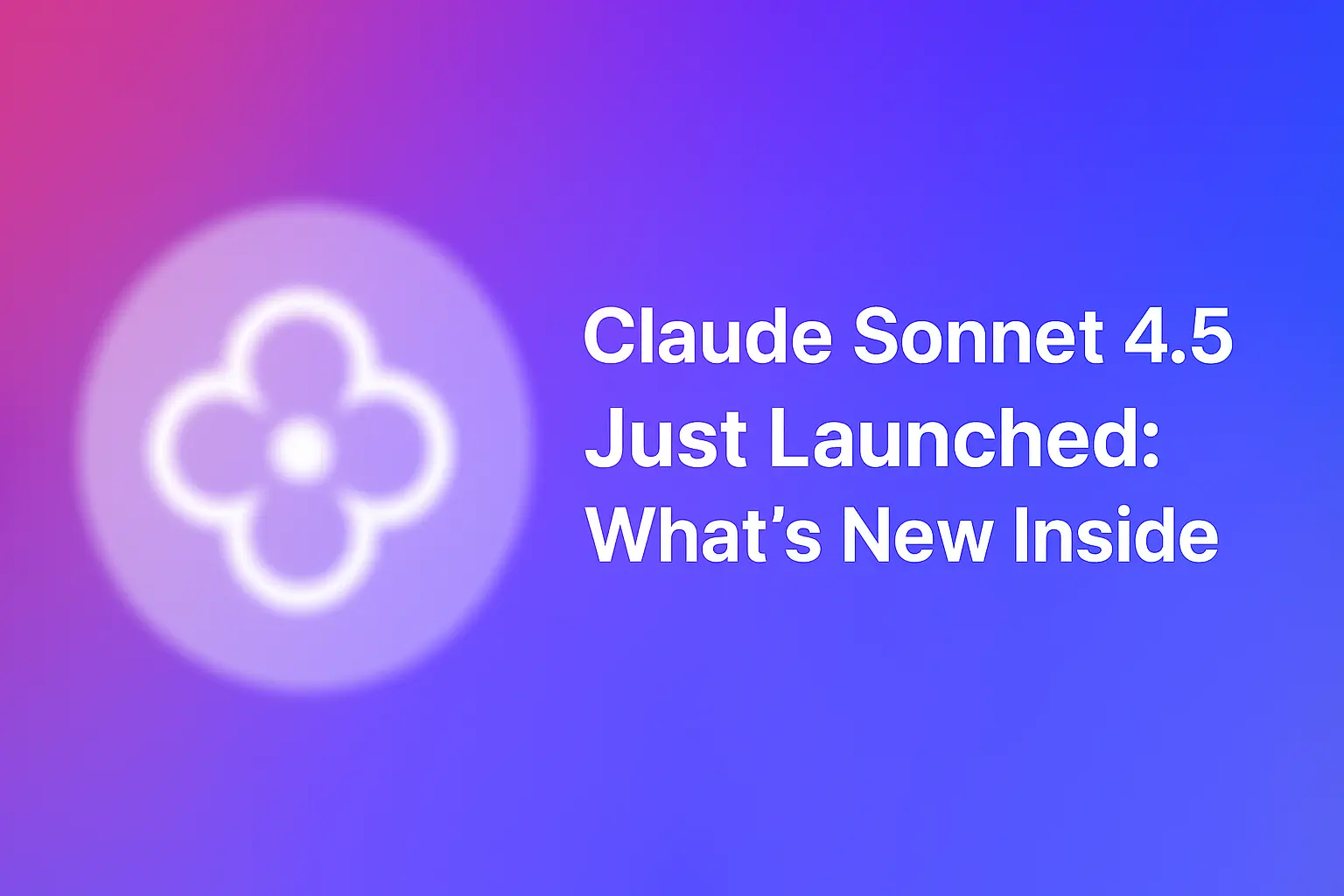The AI world just got more exciting. With the unveiling of Claude Sonnet 4.5, Anthropic has pushed its model lineup further, aiming to blur the line between tool and collaborator. If you’re curious about what upgrades this version brings, how it performs compared to past models, and whether it’s worth adopting, read on. I’ll walk you through the improvements, features, caveats, and what it means for developers, creators, and curious users alike.
This article dives deep into what’s inside Claude Sonnet 4.5, with clear comparisons, practical insights, and hands‑on impressions to help you decide whether to try it or wait.
The Big Picture: Why Claude Sonnet 4.5 Matters
Launching a “.5” version may sound incremental, but in AI terms, Claude Sonnet 4.5 is a significant leap. Anthropic is positioning this model not just as a better language assistant but as a more powerful agent, one able to sustain longer, more complex workflows and code autonomously for extended periods.
In their internal tests, Claude Sonnet 4.5 was able to build a web app by itself over more than 30 hours—far beyond the 7‑hour limit of its predecessor Opus models. It marks a shift in expectation: not just giving correct answers, but running multi-step tasks stably over time.
By releasing Claude Sonnet 4.5, Anthropic is signaling that their direction is toward agentic AI—models that don’t just respond to prompts but undertake multi-stage work, maintain state, manage context, and tie together tool usage, memory, and reasoning.
What’s New Inside Claude Sonnet 4.5
Let’s zoom into the major improvements that set Claude Sonnet 4.5 apart. These are the features and upgrades people are buzzing about.
Longer Autonomous Operation: 30+ Hours of Coding
One of the standout advancements is the ability to operate autonomously for extended sessions. Previous models were limited in how long they could maintain chain-of-thought integrity or keep context alive across tool invocations. Claude Sonnet 4.5 raises that bar. In internal demos, the model built full web app components over 30 hours straight.
This means fewer resets, fewer memory re-injections, and smoother workflows when handling large, multi-stage projects.
Smarter Coding, Deeper Context, Agent Capability
On coding tasks, Sonnet 4.5 shows improvements in reasoning, math, domain-specific logic, and tool orchestration. Anthropic claims it leads on benchmarks like OSWorld for computer use tasks, with about 61.4% in testing. Previous models scored lower.
Within developer tools, the model now integrates better persistence: it asks clarifying questions instead of making dangerous assumptions. It also uses memory mechanisms, context editors, and agent orchestration to manage long workflows.
Feature Additions: Checkpoints, VS Code Integration, “Imagine with Claude”
Alongside performance upgrades, the rollout includes developer-facing enhancements:
- Checkpoints in Claude Code let you save progress mid‑workflow and rollback if needed.
- A VS Code extension brings Claude directly into your IDE, smoothing transitions between editing and AI assistance.
- “Imagine with Claude” is a research preview where the model generates software on the fly, turning ideas into code dynamically.
- Context editing and memory tools in the API help clear stale or irrelevant data, making long workflows more stable and coherent.
These are smart moves: the upgrades aren’t just backend boosts but tools that developers will see in daily workflows.
Pricing & Access: No Change (for Now)
Interestingly, Anthropic has kept the same pricing structure as Sonnet 4 for input/output tokens ($3 / $15 per million tokens). For many users, the impulse is to worry: “Will this cost more?” But for now, they’re keeping cost stable while pushing performance higher.
Access-wise, Sonnet 4.5 is rolling out across the Claude ecosystem, including API, Claude Code, and supported platforms. It’s now the default model in some tools (e.g. Augment Code) and is available in places like GitLab Duo.
How Claude Sonnet 4.5 Feels in Real Use
Theory and specs are great—I want to talk about user experience, because that often determines whether you adopt the new version.
Users and developers are reporting it feels more reliable, more “colleague-like” rather than just a prompt engine. As one Reddit commenter noted:
“From my early 3 hours coding session with Sonnet 4.5, it is redeeming itself … it feels magic again.”
Another noted that Sonnet 4.5 became the default in their Claude Code setup:
“Yes it is… testing it now. Default Sonnet 4.5 and Opus. RIP Opus plan mode, though.”
These impressions point to increased stability, fewer mid-task disconnects, and better handling of longer interactions. But because this is fresh, some users mention not seeing all features (like full 1M context window) immediately for their accounts.
So your mileage may vary, depending on your plan, rollout region, or feature access.
Strengths & Use Cases: Where Claude Sonnet 4.5 Excels
Given the upgrades, here are areas where Claude Sonnet 4.5 looks particularly strong:
- Complex application building: writing code, managing modules, spinning up multi-component systems.
- Agent orchestration and tool chaining: cleaning context, invoking APIs, managing state across tasks.
- Domain logic and reasoning: finance, scientific domains, regulatory workflows, code + mathematics integration.
- Long-term workflows: projects that span hours or days, not just short interactions.
- Embedded developer support: inside IDEs, dev tools, pipelines where context continuity matters.
If your usage involves short chat responses, 4.5 may not feel drastically different. But if you push the limits—large codebases, multi-step logic, agent systems—this is where the gains shine.
Possible Caveats & Things to Watch
No release is without tradeoffs or unknowns. Here are important caveats:
First, feature rollout may be staggered. Not all users or accounts see every capability immediately (e.g. memory, 1M context). Some threads report that certain “max users” don’t yet have 1M context enabled.
Second, long sessions still risk staleness or drift. Even though 30+ hours is possible in tests, real-world usage with diverse tasks, context switching, and memory dependencies may show degradation or needing resets.
Third, while pricing held steady now, future versions or premium tiers may adjust costs. Scaling to more usage or higher throughput might expose hidden costs.
Fourth, models that act as agents carry higher responsibility: errors propagate, debugging agentic behavior is harder than correcting individual responses.
Fifth, the upcoming regulatory, safety, or alignment controls could impose limits or guardrails that change with future versions.
Why Claude Sonnet 4.5 Pushes the AI Narrative Forward
This isn’t just another version bump. The Claude Sonnet 4.5 launch signals a move toward AI tools that think, build, and act over time, rather than respond in bursts.
By enabling long agentic sessions, more stable memory use, better context management, and developer tooling integration, Anthropic is betting on a future where AI isn’t just an assistant but a persistent collaborator.
This release also stiffens competition with models like GPT‑5, Gemini, and others pushing in the direction of autonomous agents, tool use, and real software creation. And since Sonnet 4.5 is a more efficient, possibly more cost-effective option than some flagship models (like Opus), it may be the practical path for many users.
FAQs about Claude Sonnet 4.5
What is Claude Sonnet 4.5?
It’s the newly released version of the Claude Sonnet line from Anthropic. It brings longer session capacity, better coding and reasoning, agentic features, and new developer tools.
Does Claude Sonnet 4.5 cost more than Sonnet 4?
No. Anthropic has maintained the same pricing per input/output tokens as Sonnet 4.
Where can I use Claude Sonnet 4.5?
It’s rolling out across the Claude ecosystem including API access, Claude Code, developer platforms, and integrated tools like GitLab Duo.
Does it support 1 million tokens of context?
While Claude Sonnet 4 now supports a 1M token context window, usage in 4.5 may follow or use related context enhancements.
Is 30 hours of autonomous operation realistic?
In demonstrations, yes. But real-world performance may vary depending on task complexity, context changes, memory use, and API invocation.
Should I upgrade from Sonnet 4 to 4.5 immediately?
If your projects push limits—large codebases, long workflows, agentic tasks—then yes, it’s worth testing. If your use is lighter or simple, you might not see dramatic differences yet.




